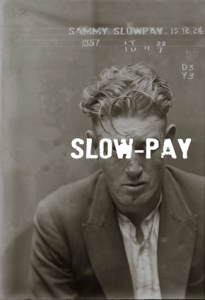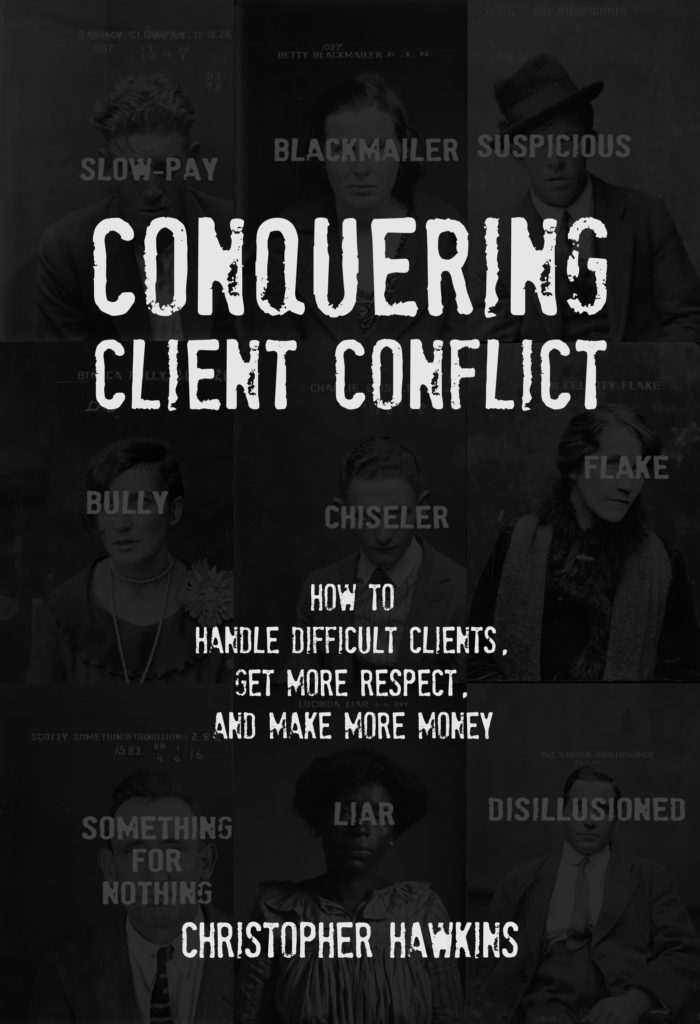
Welcome to Day 7 of the Conquering Client Conflict course!
Did you get here from a link from a friend? To get access to all the content, make sure you sign up for this free training right here.
 The first phase of the project has been delivered to the client. The check should be in the mail by now (or deposited to your bank or PayPal account, depending on your system). So you checked…and it’s not yet there. You wait for a day, or two, or more, and still the money isn’t in sight. What to do?
The first phase of the project has been delivered to the client. The check should be in the mail by now (or deposited to your bank or PayPal account, depending on your system). So you checked…and it’s not yet there. You wait for a day, or two, or more, and still the money isn’t in sight. What to do?
Late payments, ugh. For a freelancer without a steady paycheck, payments that aren’t arriving according to schedule can be painful, and a source of anxiety and aggravation. Even if you have a stable of regularly paying clients that make your income more or less predictable, slow-paying clients will seriously impact cash flow and impede your business operations.
If this happens to you, here are some action steps that will help you deal with slow-paying clients:
Presume goodwill.
First, take a deep breath. Chasing money that you rightfully deserve may not feel like a dignified endeavor, so it’s normal to feel bad about the situation — or to feel angry toward the client. There are just so many horror stories documented about freelancers not getting paid at all, because they don’t have the clout or legal resource to defend themselves. Every single one of us knows at least one colleague with such a story.
But unless you have the entire story, avoid jumping into conclusions. Don’t assume that the client is broke or trying to rip you off. In fact, they may even be embarrassed about not being able to pay you on time. At this point, it can help if you can try to be empathetic to their situation…for now. The first thing you need to do is ask why. Allow them to explain why they’re not paying according to schedule.
Create two-way accountability.
Educate clients about the importance of their responsibility to the project. In this case, timely payment allows their project to continue on schedule, with access to needed pre-scheduled resources. Continue to politely-but-firmly demand payment.
Enumerate the consequences of failing that responsibility.
Your contract should state, in clear terms, what happens if one of you doesn’t hold up your part of the deal. In terms of late payments, let the client know that their project may be terminated or postponed in favor of a paid-up client project. Continue to politely-but-firmly demand payment.
Hold the line.
If the client still won’t work with you on solving the problem, hold on to your original position. Remind and clarify once again the policies and original boundaries that have been set from the very beginning. Re-communicate the terms: You can’t service a project that isn’t paying for itself. Continue to politely-but-firmly demand payment.
On the other hand, be flexible to other viable alternatives. Continue saying “no” to their current behavior, but keep an open mind to an acceptable option. For instance, you may both agree to reducing the scope of the remaining work for the project, so it reduces the fees as well.
Be consistent.
If you’re still not getting the response you deserve and need, just continue with your efforts and remain consistent with your responses. If after a reasonable period of time and you have still not arrived at a fair resolution, consider whether it’s time to end the relationship and to invest in developing policies and systems that will help reduce the possibility of late payments messing up with your business — and your peace of mind — again. Continue to politely-but-firmly demand payment.
How can you get ahead of this next time?
As we’ve talked about before, getting out ahead of conflicts before they happen is the best form of conflict resolution there is. And just like everything else we talked about, you can get ahead of slow-paying clients:
Ask for a deposit. If you’re not getting deposits for well-scoped work, please start doing so immediately. “But…that will kill the deal with some clients!” you say? Yes, it will. The question is, if being slow-paid is a big enough issue that you’re reading this to learn how to deal with it, shouldn’t you want to lose those clients? Raw survival aside, if you’re in a position to use a deposit as a filter for which clients you will or will not work with, you’ll never regret it.
Ask for a bigger deposit. If you’re in the habit of asking for a deposit against your projects, congratulations! You’re being proactive about mitigating the risk of slow-paying clients. But consider this…if that remaining payment is late – really late – where does that leave you? If you’re taking 25% up-front, try asking for more. If that freaks you out, you don’t have to make a huge jump; try bumping up your standard deposit to 33% next time. Then go to 50%. Progress is progress, even in small increments.
Ask for all the money up front. This is a strong move, and not every client is going to go along with it. Most businesses have certain expectations before they ever pick up the phone to call one of us, and those expectations generally do not include handing us a gigantic check before we’ve produced any work. That said, if you present yourself correctly and sell the client on the legitimate benefits of your service and their project, it can’t hurt to try. Warning: if you take all the money up-front, you’d better be able to perform.
Bill with shorter terms.
For those of you who tend to do work that resembles “staff augmentation” gigs, or who tend to take in a steady stream of work, asking for deposits might not make sense at all (although retainers might, but we’ll talk about that another day). In those cases, the key is to not let any one client get too deep into you, receivables-wise. You’re not an investment bank – you are a vendor, pure and simple. If the plumber gets paid right away, so should you. If you’re billing monthly, try billing on Net 15. If you want to grandfather in your existing clients because you’re afraid to create a panic, fine – roll out your new billing terms on your next project.
By establishing these practices up front, you’ll be mitigating the damage that a slow-paying client can do to you downstream.
Homework Assignment – Post Your Work To The Comments Below!
Before we get to the homework, I just want to remind you that this course isn’t the only help you’ll be able to get on this topic. The course was developed using material I wrote for a book.
I thought that having a cover designed before the book was complete might help motivate me to finish the book, and I’d like to share it with you now. Here’s the worlds first look at Conquering Client Conflict, the book:

If the course has been helpful to you and you think a whole book on the topic would be even better – cool your jets, Turbo! If you can finish the course, I have a great book-related reward to offer you. But no cheating – read the chapters & do your homework, and you’ll get your reward on Day 11.
So, let’s get on with the homework!
1) Do you currently have any clients who are more than one billing cycle behind on paying you?
2) What have you done in an attempt to collect?
3) Have you ever had to dismiss a client over payment issues? If so, did you ever collect what was owed to you?
